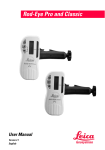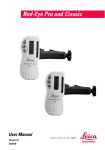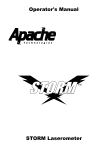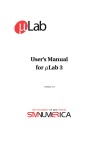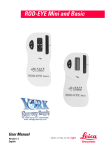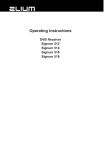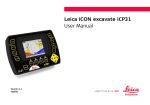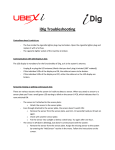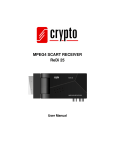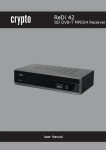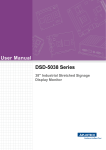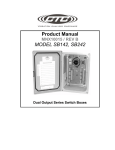Download Pmb+Cwc Npm _lb Aj_qqga
Transcript
Rod-Eye Pro and Classic User Manual Version 2.0 English This manual contains important Safety Directions (refer to chapter Safety directions) as well as instructions for setting up the product and operating it. Read carefully through the User Manual before you switch on the instrument. The symbols used in the User Manual have the following meaning: DANGER: Indicates an imminently hazardous situation which, if not avoided, will result in death or serious injury. WARNING: Indicates a potentially hazardous situation or an unintended use which, if not avoided, could result in death or serious injury. CAUTION: Indicates a potentially hazardous situation or an unintended use which, if not avoided, may result in minor or moderate injury and / or appreciable material, financial and environmental damage. ! Important paragraphs which must be adhered to in practice as they enable the product to be used in a technically correct and efficient manner. Product Identification The instrument model and serial number of your product are indicated on the label on the base of the unit. Enter the model and serial number in your manual and always refer to this information when you need to contact your agency or authorized service workshop. Model-Serial Number: _____________ Date of purchase:_____________ Copyright Notice Copyright 2004 by Leica Geosystems GR LLC. All rights reserved Leica Geosystems Proprietary Information The information/data contained herein is proprietary information of Leica Geosystems GR LLC and is furnished for your controlled use, and shall not be copied or otherwise reproduced, nor in any manner disclosed to any third party, without Leica Geosystems’s prior written content. Rod-Eye Pro and Classic 2.0.0en 2 Table of Contents Introduction .................................. 4 General Information ................... 5 Rod-Eye Pro and Classic Front View...................................... 5 Rod-Eye Pro and Classic Rear View ...................................... 6 Secondary Switch Functions (Rod-Eye Pro only) ........................ 7 LCD Test Mode for Rod-Eye Pro and Classic .................................... 7 Rod-Eye Pro and Classic Display Functions .......................... 8 Rod-Eye Pro Clamp..................... 10 Technical Data ........................... 11 Rod-Eye Pro and Classic............. 11 Rod-Eye Pro (only) ...................... 11 Rod-Eye Classic (only) ................ 12 Warranty...................................... 13 Care and Transport .................. 14 Transport ..................................... 14 Storage ........................................ 14 Cleaning and Drying Windows..... 14 Safety Directions ...................... 15 Intended Use of Product .............. 15 Permitted uses........................... 15 Adverse uses ............................. 15 Limits of Use ................................ 15 Responsibilities............................ 15 Hazards of Use ............................ 16 Electromagnetic Compatibility (EMC) .......................................... 17 FCC Statement (applicable in the U.S.) ................ 18 Labeling ....................................... 19 Table of Contents 3 Rod-Eye Pro and Classic 2.0.0en Introduction The ROD-EYE Pro and Classic handheld laser detectors are designed to receive reference elevation information from all rotating laser levels. The detectors are designed to receive invisible laser beams as well as visible beams from Helium-Neon and diode lasers. All models include a Liquid Crystal Display (LCD) on the front and rear for easy visual indication of the reference plane of laser light. A beeper also emits an audible tone that indicates on-grade, high or low. Accuracy levels are user selectable to meet various job requirements, including industrial applications. The detectors have been specifically designed for use in harsh, loud construction environments. Impact resistant housings, recessed windows, waterproof design, durable battery contacts, and a high volume beeper are incorporated into every detector. A general purpose clamp is designed to mount the detector on various grade rods and staffs. The clamp can be mounted to round, oval, square, and rectangular rods, as well as various sizes of wooden staffs. Rod-Eye Pro and Classic 2.0.0en 4 Introduction General Information Rod-Eye Pro and Classic Front View 1 Power Switch – Turns the detector on and off. Press once to turn the unit on. Press and hold the switch for 1.5 seconds to turn the unit off. 2 Accuracy Switch – Selects the detection accuracy. Pressing the switch will cycle the detector through four levels of accuracy. 3 Audio Switch – Selects the audio level. Pressing this switch will cycle the detector between off, low and loud levels. When the sound has been turned off, a single beep will indicate when the laser beam has been detected. 4 Liquid Crystal Display (LCD) – Front and rear LCD’s indicate the detector’s position relative to the laser beam and detector settings. 5 On-Grade Mark – This mark is aligned with the on-grade reading of the LCD. The top of the detector is 2” (50 mm) above this mark. 6 Laser Reception Window – The set of photocells located behind this window detect the laser signal. The window (photocells) must be directed towards the laser. 7 Audio Speaker – A fast beeping signal indicates that the detector is too high. A solid tone indicates that the detector in on-grade. And, a slow beeping signal indicates that the sensor is too low. Rod-Eye-1 General Information 5 Rod-Eye Pro and Classic 2.0.0en Rod-Eye Pro and Classic Rear View 8 Captive Screw Thread – This threaded hole accepts the rod clamp screw to secure the detector to the clamp. 14 8 9 9 Offset Notch – This notch is used for transferring reference marks. The notch is 2” (50 mm) below the top of the detector. 13 10 10 Clamp Guides – The guides are used to secure and align the detector on the rod clamp. 11 Battery Door Latch – The latch is located at the bottom of the detector. Use a coin to open and install or replace the batteries. 12 12 Battery Compartment – The compartment is watertight and holds two “AA” alkaline batteries. New batteries must be installed in the positions noted on the diagram found in the compartment. 11 Rod-Eye-2 13 Rear Liquid Crystal Display (LCD) – This display functions the same as the front LCD. (Rod-Eye Pro shown.) 14 Serial Number Label – Use as your reference should you have any questions regarding your detector. General Information 6 Rod-Eye Pro and Classic 2.0.0en 4 Industrial Bandwidths – Press and hold the Power “Shift” Switch, then press and hold the Audio Switch for 1.5 seconds to change from the four standard accuracy bands to three industrial bandwidth accuracies (see specifications). The unit will beep once and the accuracy band indicator on the LCD will continue to flash to indicate to the user that the detector is set for the industrial bandwidths. Press the Accuracy Switch to select the desired bandwidth. Turning off the power will cause the accuracy to revert to the standard accuracy bands. Secondary Switch Functions (Rod-Eye Pro only) Rod-Eye-3 1 Power Switch – This switch functions also as a “shift” key. When the unit has been turned on, pressing and holding this switch will enable other switch functions. 5 Last Beam Strike Memory – Press and hold both the Accuracy Switch and the Audio Switch for 1.5 seconds to disable or enable this function. 2 Backlighting – Press both the Accuracy Switch and the Audio Switch at the same time to turn on the LCD backlighting. Pressing both again turns off the backlighting. LCD Test Mode for Rod-Eye Pro and Classic 3 Automatic Shutoff – Press and hold the Power “Shift” Switch and press the Accuracy Switch to change the automatic shutoff time from 0.5 hours to 24 hours. The selection will be indicated by the clock and time symbols on the LCD. With sensor off, press and hold all three switches simultaneously. The display will show each symbol individually. Press the Power Switch to exit the test mode. To completely disable the automatic shutoff, hold both switches for 1.5 seconds or until the unit beeps once and the clock and time symbols turn off on the LCD. Turning off the power will cause the automatic shutoff to return to 0.5 hours. General Information 7 Rod-Eye Pro and Classic 2.0.0en Rod-Eye Pro and Classic Display Functions Rod-Eye Pro Rod-Eye Classic 1 7 2 6 1 2 3 3 5 5 4 Rod-Eye-4 5 Rod-Eye Pro: Multi-channel Grade Indication – The center bar indicates an on-grade position. As the detector approaches the ongrade position, the arrows fill in to indicate the laser position. The “up” arrow indicates that the detector is below grade. The “down” arrow indicates that the detector is above grade. 1 Audio Indicator – Indicates the level of volume set by the operator. The symbol disappears if the audio function is turned off. 2 Battery Indicator – Indicates that there may be up to two hours remaining when the battery symbol is empty. Fresh “AA” batteries will provide up to 70+ hours of battery life. Rod-Eye Classic: Five-channel Grade Indication – The center bar indicates an on-grade position. As the detector approaches the ongrade position, the display shows the directional arrow, the arrow plus the center bar, then the center bar. The “up” arrow indicates that the detector is below grade. The “down” arrow indicates that the detector is above grade. 6 LCD Backlight Symbol – The light bulb symbol indicates that the LCD backlighting has been turned on. (Rod-Eye Pro only) 3 Accuracy Indicators – Pressing the Accuracy Switch will change the accuracy setting of the detector as indicated by the symbols on the display. See the specifications later in this manual for the bandwidth accuracies of the standard and industrial bandwidths. (Rod-Eye Pro only) 4 Laser Low Battery Warning – The symbol shown will appear if being used with a Rugby Laser and the laser is approaching a low battery condition. (Rod-Eye Pro only) Rod-Eye Pro and Classic 2.0.0en 8 General Information 7 Automatic Shutoff Indicator – The clock and time indicate a 0.5 hour or 24 hour shutoff has been selected. If no symbol appears, the automatic shutoff has been disabled. (selectable on Rod-Eye Pro only) The Rod-Eye Classic shuts off automatically after 0.5 hours. General Information 9 Rod-Eye Pro and Classic 2.0.0en Rod-Eye Pro Clamp 1 Captive Screw, Rod Clamp – Used to attach the detector to the clamp. 3 1 2 2 Alignment Points – The points are used to secure and align the detector to the rod clamp. 4 3 Reference Indicators – These points are aligned with the detector’s on-grade location for accurate grade rod readings. 5 6 7 4 Clamping Screw and Knob – Tightening this screw locks the clamp onto rods and staffs by moving the traveling jaw. 8 Rod-Eye-5 Rod-Eye Pro Clamp with reversible jaw 6 5 Reversible Jaw Face – The slanted face is used to tightly grip round and oval rods. Reverse the face to grip flat, rectangular and square rods. 6 Traveling Jaw – Move the jaw by tightening the Clamping Screw and Knob to lock onto rods and staffs. 7 Flathead Screw – This screw holds the Reversible Jaw Face in place. 8 Rod-Eye-6 Rod-Eye Classic Clamp (no reversible jaw) Rod-Eye Pro and Classic 2.0.0en 10 8 Optional Bubble Vial Kit – The vial aids in keeping the grade rod plumb when taking readings. General Information Technical Data Rod-Eye Pro and Classic Working Radius: ....................... 1 meter - 300 meter (3 ft. - 1000 ft.) .................................................. Laser dependent Detection Height: ...................... 50 mm (2") Reception Angle: ...................... ± 45° Detectable Spectrum: ............... 610 nm to 900 nm Beeper Volumes: ...................... High 110 dBA .................................................. Low 90 dBA Power Supply:........................... 2 x 1.5 Volt "AA" batteries Battery Life:............................... 70+ hours Weight:...................................... 280 g (10 oz.) without clamp .................................................. 450 g (16 oz.) with clamp Dimensions: .............................. 163 x 74 x 30 mm without clamp .................................................. (6.4" x 2.9" x 1.2") Operating Temperature: ........... -20°C to 60°C (-4° F to +140° F) Storage Temperature:............... -40°C to 70°C (-40° F to +158° F) Rod-Eye Pro (only) Detection Accuracy:.................. Standard Accuracy Bandwidth: Super Fine ±0.50 mm Fine ±1.00 mm Medium ±2.00 mm Coarse ±3.00 mm (±0.020") (±0.040") (±0.080") (±0.120") Industrial Accuracy Bandwidth: Zero Bandwidth ±0.000 mm (±0.0000") Fine Industrial ±0.064 mm (±0.0025") Coarse Industrial ±0.127 mm (±0.0050") LCD Backlighting ...................... Yes, front and rear Automatic Shut Off.................... Selectable - 30 minutes, 24 hours, none Memory, Last Beam Strike ....... yes Laser Low Battery Warning ...... yes Grade Display ........................... Multi-channel arrow display Warranty ................................... 36 months Technical Data 11 Rod-Eye Pro and Classic 2.0.0en Rod-Eye Classic (only) Detection Accuracy:.................. Standard Accuracy Bandwidth Fine ±1.00 mm Coarse ±3.00 mm LCD Backlighting ...................... no Automatic Shut Off.................... 30 minutes Memory, Last Beam Strike ....... no Laser Low Battery Warning ...... no Grade Display ........................... Five-channel arrow display Warranty ................................... 24 months Rod-Eye Pro and Classic 2.0.0en 12 (±0.040") (±0.120") Technical Data Warranty Leica Geosystems warrants all products it manufactures to be free if defects in materials and workmanship under normal use and service, provided that the product has been properly used and cared for as stated in the User Manual. Any evidence of an attempt to repair the product by other than factory authorized personnel using Leica Geosystems certified replacement parts will automatically void the warranty. Warranty Period: Rod-Eye Pro: Rod-Eye Classic: 36 months 24 months Leica Geosystems liability under this warranty is limited to repairing or replacing any product returned to a factory authorized service facility for that purpose. The foregoing states the entire liability of Leica Geosystems in connection with the product, and they shall not be held responsible for any consequential damage of any kind. The foregoing is in lieu of all other warranties expressed or implied. The user of the product is expected to follow all operating instructions, periodically checking the instrument and the work as it progresses. Warranty 13 Rod-Eye Pro and Classic 2.0.0en Care and Transport Transport Storage ! ! When dispatching the instrument, always use the complete original Leica Geosystems packaging (case and cardboard box). When transporting the instrument in the field, always make sure that you: • Either carry the instrument in its original transport case • Or carry the tripod with its legs splayed across your shoulder, keeping the attached instrument upright. Temperature Limits (-40° to 70°C / -40° to 158°F) Respect the temperature limits when storing the instrument, particularly in summer if the instrument is inside the vehicle. ! Damp instruments must be unpacked. Dry the instrument, the case and the accessories at not more than 40°C / 108°F and clean them. Do not repack until everything is completely dry. Cleaning and Drying Windows Never carry the instrument loose in a road vehicle. It can be affected by shock and vibration. Always carry it in its case and secure it. ! • When transporting the instrument by rail, air or ship, always use the complete original packaging (case and cardboard box), or its equivalent, to protect it against shock and vibration. • ! After transport, or after long periods of storage, inspect the field adjustment parameters given in this user manual before using the instrument. Rod-Eye Pro and Classic 2.0.0en 14 Windows Never touch the glass with your fingers. Use only a clean, soft, lint-free cloth for cleaning. If necessary, moisten the cloth with pure alcohol. Use no other liquids; these may attack the polymer components. Care and Transport Safety Directions The following directions should enable the person responsible for the product, and the person who actually uses the euipment, to anticipate and avoid operational hazards. The person responsible for the product must ensure that all users understand these directions and adhere to them. WARNING: Adverse use can lead to injury, malfunction, and material damage. It is the task of the person responsible for the equipment to inform the user about hazards and how to counteract them. The product is not to be used until the user has been instructed how to work with it. Intended Use of Product Limits of Use Permitted uses Environment: The product is intended for the following applications: • Suitable for use in an atmosphere appropriate for permanent human habitation. Cannot be used in an aggressive or explosive environment. Refer to section “Technical Data.” Detecting a rotating laser beam. Adverse uses • Use of the product without instruction. • Use outside of the intended limits. • Disabling safety systems. • Removal of hazard notices. • Opening the product using tools (screwdriver, etc.), unless this is specifically permitted for certain functions. • Modification or conversion of the product. • Use after misappropriation. • Use with accessories from other manufacturers without the prior express approval of Leica Geosystems. Safety Directions Responsibilities Responsibility for the manufacturer of the original equipment Leica Geosystems GR LLC, Grand Rapids, MI 49546, U.S.A. (hereinafter referred to as Leica Geosystems): Leica Geosystems is responsible for supplying the product, including the user manual and original accessories, in a completely-safe condition. 15 Rod-Eye Pro and Classic 2.0.0en Responsibilities of the manufacturers of non-Leica Geosystems accessories: Hazards of Use ! Main hazards of use The manufacturers of non-Leica Geosystems accessories for the product are responsible for developing, implementing and communicating safety concepts for their products, and are also responsible for the effectiveness of those safety concepts in combination with the Leica Geosystems product. WARNING: The absence of instruction, or the inadequate imparting of instruction, can lead to incorrect or adverse use, and can give rise to accidents with far-reaching human, material, financial, and environmental consequences. Precautions: All users must follow the safety directions given by the manufacturer and the directions of the person responsible for the product. Responsibilities of the person in charge of the equipment: WARNING: The person responsible for the equipment must ensure that it is used in accordance with the instructions. This person is also accountable for the training and the deployment of personnel who use the equipment and for the safety of the equipment in use. CAUTION: Watch out for erroneus measurements if the product has been dropped or has been misused, modified, stored for long periods or transported. Precautions: Periodically carry out test measurements and perform the field adjustments indicated in the user manual, particularly after the product has been subjected to abnormal use before and after important measurements. The person in charge of the product has the following duties: • To understand the safety instructions on the product and the instructions in the user manual; • To be familiar with local regulations relating to accident prevention; • CAUTION: If the accessories used with the equipment are not properly secured and the equipment is subjected to mechanical shock (i.e. blows, falling), the equipment may be damaged or people may sustain injury. To inform Leica Geosystems immediately if the equipment becomes unsafe. Rod-Eye Pro and Classic 2.0.0en 16 Safety Directions Precautions: When setting-up the equipment, make sure that the accessories (i.e. tripod, tribrach, connecting cables) are correctly adapted, fitted, secured, and locked in position. Avoid subjecting the equipment to mechanical shock. Electromagnetic Compatibility (EMC) WARNING: If the equipment is improperly disposed of, the following can happen: • If polymer parts are burnt, poisonous gases are produced which may impair health. • If batteries are damaged or are heated strongly, they can explode and cause poisoning, burning, corrosion, or environmental contamination. • The term "electromagnetic compatibility" is taken to mean the capability of the product to function smoothly in an environment where electromagnetic radiation and electrostatic discharges are present, and without causing electromagnetic disturbances to other equipment. WARNING: Electromagnetic radiation can cause disturbances in other equipment. Precautions: Although the product meets the strict regulations and standards which are in force in this respect, Leica Geosystems cannot completely exclude the possibility that other equipment may be disturbed. By disposing of the equipment irresponsibly you may enable unauthorized persons to use it in contavention of the regulations, exposing themselves and third parties to the risk of severe injury and rendering the environment liable to contamination. CAUTION: There is a risk that disturbances may be caused in other equipment if the product is used in conjunction with accessories from other manufacturers, i.e. walkie-talkies, non-standard cables, external batteries. Precautions: Dispose of the equipment appropriately in accordance with the regulations in force in your country. Always prevent access to the equipment by unauthorized personnel. Precautions: Use only the equipment and accessories recommended by Leica Geosystems. When combined with the product, they meet the strict requirements stipulated by the guidelines and standards. CAUTION: Disturbances caused by electromagnetic radiation can result in the tolerance limits for measurements being exceeded. Safety Directions 17 Rod-Eye Pro and Classic 2.0.0en Although the product meets the strict regulations and standards which are in force in this connection, Leica Geosystems cannot completely exclude the possibility that the product may be disturbed by very intense electromagnetic radiation, i.e. near radio transmitters, walkie-talkies, diesel generators. • Consult the dealer or an experienced radio/TV technician for help. • Reorient or relocate the receiving antenna. • Connect the equipment into an outlet on a circuit different from that to which the receiver is connected. Precautions: Check the plausibility of results obtained under these conditions. WARNING: Changes or modifications not expressly approved by Leica Geosystems could void the user's authority to operate the equipment. FCC Statement (applicable in the U.S.) WARNING: This equipment has been tested and found to comply with the limits for a Class B digital device, pursuant to part 15 of the FCC rules. These limits are designed to provide reasonable protection against harmful interference in a residential installation. This equipment generates, uses and can radiate frequency energy and, if not installed and used in accordance with the instructions, may cause harmful interference to radio communications. However, there is no guarantee that interference will not occur in a particular installation. If this equipment does cause harmful interference to radio or television reception, which can be determined by turning the equipment off and on, the user is encouraged to try to correct the interference by one or more of the following measures: • Increase the separation between the equipment and the receiver. Rod-Eye Pro and Classic 2.0.0en 18 Safety Directions Labeling Rod-Eye-7 Rod-Eye Pro Rod-Eye-8 Rod-Eye Classic Safety Directions 19 Rod-Eye Pro and Classic 2.0.0en Leica Geosystems GR LLC is an ISO 9001 Registered Company. 727273-2.0.0en Printed in Switzerland Copyright Leica Geosystems GR LLC Grand Rapids, Michigan, 2004 (Original Text) Leica Geosystems GR LLC 6330 28th Street SE Grand Rapids, Michigan 49546 http://construction.leica-geosystems.com www.leica-geosystems.com




















